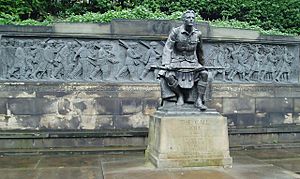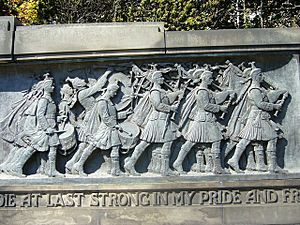Scottish American Memorial facts for kids


The Scottish American Memorial, also known as the Scots American War Memorial, is a special monument in West Princes Street Gardens in Edinburgh, Scotland. It was first called "The Call 1914". This memorial was put up in 1927.
It shows a soldier wearing a kilt, which is a traditional Scottish skirt. The soldier is looking towards Castle Rock, where Edinburgh Castle stands. Behind the main statue, there is a detailed carving, called a frieze. This frieze shows groups of men answering the call to join the army. They are following a pipe band playing bagpipes.
This memorial was a gift from Scottish-Americans, people in America with Scottish family roots. They wanted to honor all the brave Scottish soldiers who fought in the First World War. The memorial is considered a very important building in Scotland. It is listed as a Category B building by Historic Scotland.
Contents
Building the Memorial
Why the Memorial Was Built
The Scottish American Memorial was paid for by a group called The Scottish – American War Memorial Committee. This committee represented Scottish-Americans. They wanted to show their respect for the amazing courage of Scottish troops during the First World War.
The memorial was officially revealed on September 7, 1927. The person who unveiled it was Alanson B. Houghton, who was the United States Ambassador to the United Kingdom at the time.
Who Designed the Memorial
The main designer of "The Call 1914" was R. Tait McKenzie. He was a Scottish Canadian artist. At the time, he was working at the University of Pennsylvania in Philadelphia, USA. McKenzie started his career in physical education. He only began creating sculptures later in his life. His sculptures often showed life-sized male athletes.
This particular memorial took him four years to finish. The bronze frieze behind the main statue was also designed by McKenzie. It shows Scots from different jobs answering the call to war. You can see them changing from regular people into marching soldiers. An architect named Reginald Fairlie also helped with the design. The stone parts of the memorial are made from Craigleith sandstone.
At the very top of the memorial, there are two intertwined shields. These shields represent both America and Scotland. When it was built, the memorial was said to have cost ten thousand pounds.
The Poem on the Memorial
At the bottom of the frieze, there are lines from a poem called "A Creed". The poem was written by Ewart Alan Mackintosh. The lines say: "If it be life that waits I shall live forever unconquered; if death I shall die at last strong in my pride and free."
Ewart Alan Mackintosh was a young man of Scottish descent. He was only 23 years old and had studied at Oxford University. Sadly, he was killed in 1917 during the second Battle of Cambrai in the war.

